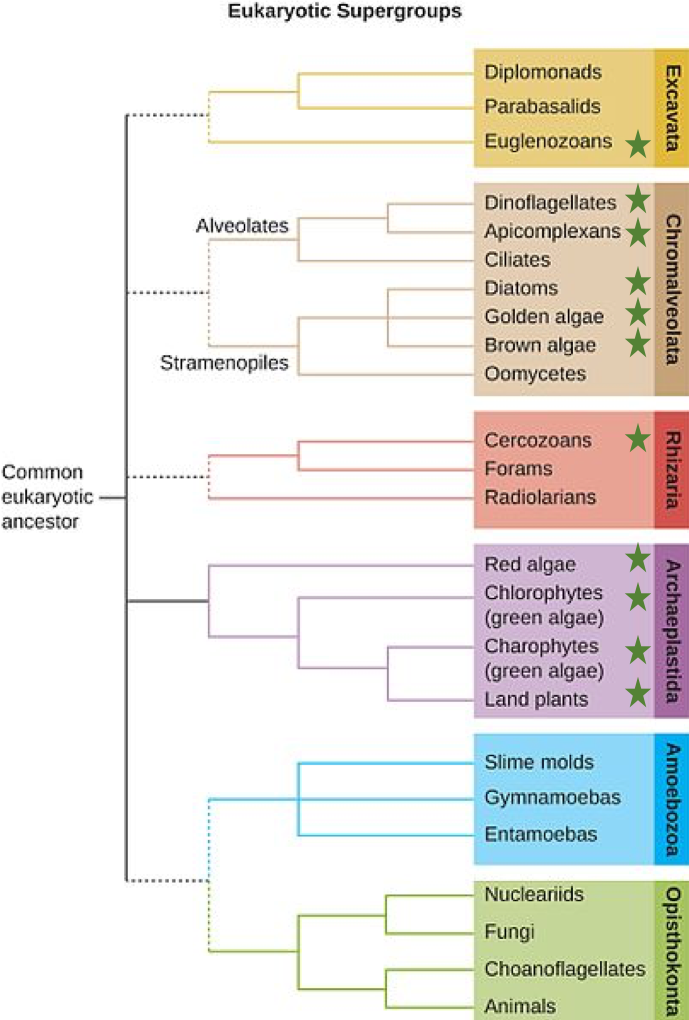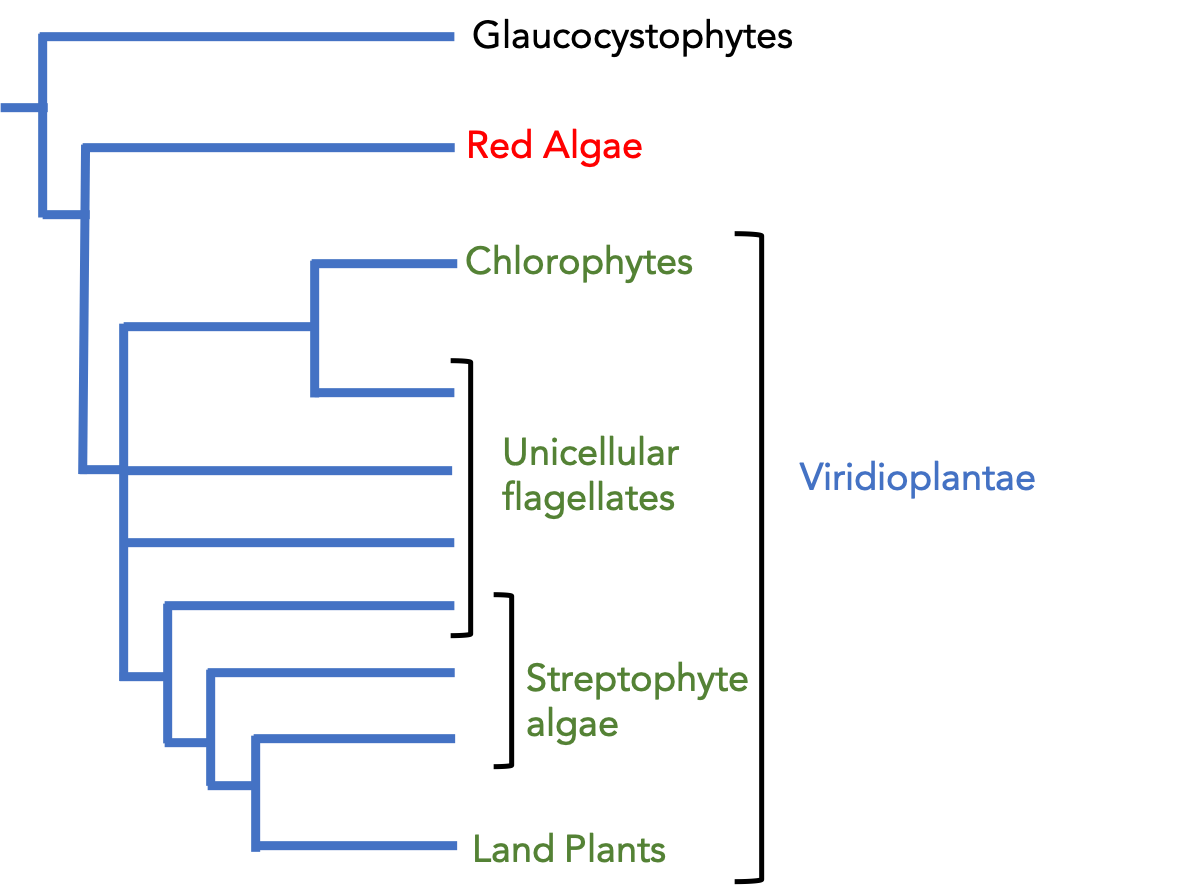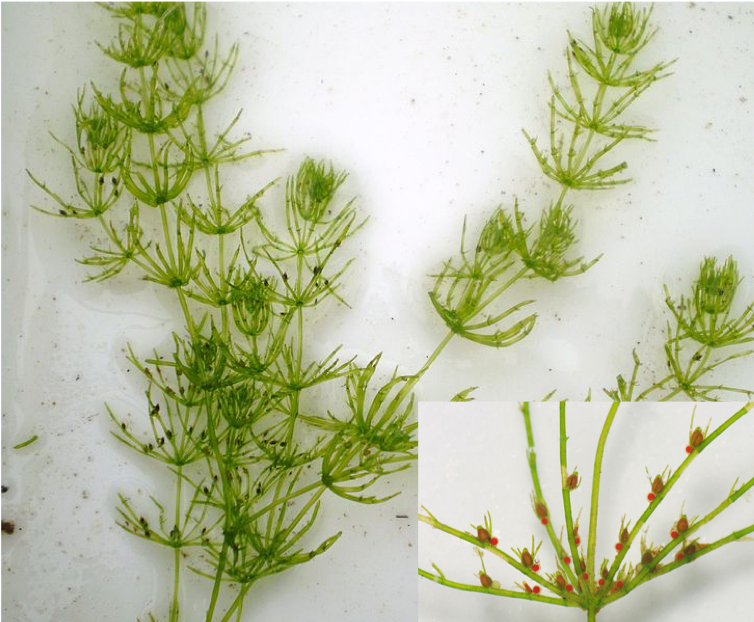Learning Goals
By the end of this reading you should be able to:
- Identify the two supergroups of Eukarya that contain plants, animals, and fungi
- Explain why the presence of photosynthesis is not used as a defining characteristic of Eukaryotic supergroups
- Compare the traits shared by green algae and land plants
- Explain the reasons why Charales are considered the closest relative to land plants
Introduction
The oldest fossils appear to all be prokaryotes, while the evidence of eukaryotes is about 2 billion years old (they appear later in the fossil record). Based on this it is probable that today’s eukaryotes are descended from an ancestor that had a prokaryotic organization. The last common ancestor of today’s Eukarya had several characteristics, including cells with nuclei that divided mitotically and contained linear chromosomes where the DNA was associated with histones, a cytoskeleton and endomembrane system, and the ability to make cilia/flagella during at least part of its life cycle. This ancestor was aerobic because it had mitochondria that were the result of endosymbiosis of an aerobic alpha-proteobacterium. Whether this ancestral cell had a nucleus at the time of the initial symbiosis remains unknown. Modern Eukarya are an amazingly diverse group of organisms, from single cells to complex multicellular organisms and with multiple means of acquiring both energy and the carbon need for building blocks.
Supergroups within the Eukarya
The emerging classification scheme groups the entire domain Eukaryota into six “supergroups” that evolved from a common ancestor and contains all of the protists as well as animals, plants, and fungi (Fig. 1).

The supergroups are believed to be monophyletic, meaning that all organisms within each supergroup are believed to have evolved from a single common ancestor, and thus all members are most closely related to each other than to organisms outside that group. There is still evidence lacking for the monophyly of some groups.
The classification of eukaryotes is still in flux, and the six supergroups may be modified or replaced by a more appropriate hierarchy as genetic, morphological, and ecological data accumulate. Keep in mind that the classification scheme presented here is just one of several hypotheses, and the true evolutionary relationships are still to be determined.
Archaeplastida
The supergroup Archaeplastida is separated into three phylogenetic groups: the Glaucocytophyes, the Red Algae, and the Viridioplantae. With only a few exceptions all of the organisms within the supergroup are photosynthetic. Photosynthesis, however, is found in other groups that are not within the Archaeplastida, including the brown and golden algae, diatoms, dinoflagellates, some apicomplexans, some excavata (Euglenids), and some Rhizarians (see Fig. 2). Red algae and green algae, however, are included in the supergroup Archaeplastida. Molecular evidence supports that all Archaeplastida are descendants of an endosymbiotic relationship between a heterotrophic protist and a cyanobacterium.
Thinking Question:
What is a possible explanation for the pattern of distribution of photosynthetic eukaryotes (they are widely distributed but discontinuously among the different groups)? Be sure to provide support for your reasoning.
Glaucophytes:

This is a small group of organisms that reside in freshwater ponds and lakes. They are unique in that their chloroplasts have walls of peptidoglycan, a feature retained from the ancestral cyanobacterial endosymbiont. In addition, their photosynthetic pigments include biliprotein which is also found in cyanobacteria.
Red Algae
Red algae, or rhodophytes, are primarily multicellular, most lack flagella, and range in size from microscopic, unicellular protists to large, multicellular forms that have differentiated tissues and in some cases complex morphology. Red algae, like land plants, have cell walls composed of cellulose and display a life cycle with an alternation of generations. There are many species of red algae that are seaweeds that are found in the shallow seafloor, however, and some species have unique pigment photosynthetic accessory pigments. These phycoerythrin pigments are red in color which allows the algae to utilize short (blue) wavelengths of light. These wavelengths are found at greater depths than the red wavelengths commonly used by other photosynthetic organisms and thus allow these algae to live at greater depths and outcompete other algae. Coralline red algae are found at the edges of coral reefs and they have the ability to secrete calcium carbonate (CaCO3) to form an external skeleton-like structure that protects them from the motion of the waves. These tiny red algae are key to the establishment of the coral reefs as they provide a needed buffer for the newly attached corals.
Viridioplantae: Green Algae
Green algae are the most abundant group of algae and exhibit similar features to the land plants. The cells in green algae divide along cell plates called phragmoplasts, and their cell walls are layered in the same manner as the cell walls of land plants. In addition, green algae contain the same carotenoids and chlorophyll a and b as land plants, whereas other algae have different accessory pigments and types of chlorophyll molecules in addition to chlorophyll a. Both green algae and land plants also store carbohydrates like starch. These similarities provide evidence that, even though green algae are classified as protists, they shared a relatively recent common ancestor with land plants.
There is wide diversity within the green algae, and while some groups are unicellular and flagellate, the Chlorophytes and the Charophytes contain members that are complex and multicellular. The Chlorophytes include more than 7000 different species that live in fresh or brackish water, in seawater, or in snow patches. A few even survive on soil, provided it is covered by a thin film of moisture in which they can live. Periodic dry spells provide a selective advantage to algae that can survive water stress. Chlamydomonas is a simple, unicellular chlorophyte with a pear-shaped morphology and two opposing, anterior flagella that guide this protist toward light sensed by its eyespot. These chlorophyte species exhibit haploid gametes and spores, which are also found in other more complex species.
The chlorophyte Volvox is one of only a few examples of a colonial organism, which behaves in some ways like a collection of individual cells, but in other ways like the specialized cells of a multicellular organism. Volvox colonies contain 500 to 60,000 cells, each with two flagella, contained within a hollow, spherical matrix composed of a gelatinous glycoprotein secretion. Individual Volvox cells move in a coordinated fashion and are interconnected by cytoplasmic bridges. Only a few of the cells reproduce to create daughter colonies, an example of basic cell specialization in this organism.
True multicellular organisms, such as the sea lettuce, Ulva, are also represented among the chlorophytes. Other chlorophytes exist as large, multinucleate, single cells. Within the genus Caulerpa some species undergo nuclear division, but their cells do not complete cytokinesis, remaining instead as massive and elaborate single cells.
While Chlorophytes share some features with land plants, the Charophytes are the closest living relatives to land plants and resemble them in both morphology and reproductive strategies. Within the charophytes, the order Charales, and the coleochaetes (microscopic green algae that enclose their spores in sporopollenin) are considered the closest living relatives of land plants. Charales have been discovered in the fossil record as far back as 420 million years ago. The organisms within this group live in a range of freshwater habitats and vary in size from a few millimeters to a meter in length.

A representative species is Chara (Fig 3), which has large cells that form a thallus: the main stem of the alga. At the nodes, smaller cells can form branches and male and female reproductive structures are established. This group also produces flagellated sperm.
Unlike land plants, green algae within the Charales do not undergo alternation of generations in their lifecycle. However, Charales do exhibit a number of traits that are significant to the adaptation to land life. They produce the compound lignin, which provides support against gravity, and sporopollenin, which helps protect spores from drying out. In addition, they form plasmodesmata that connect the cytoplasm of adjacent cells which allows for greater ease in moving molecules including water between adjacent cells. Finally, the egg, and later, the zygote, form in a protected chamber on the parent plant, again this protects against drying out.
The separation of green algae from what are considered to be plants is one that is not always clear cut. While all algae are photosynthetic—that is, they contain some form of a chloroplast—they didn’t all become photosynthetic via the same path. In contrast, the evolutionary pathways of photosynthesis in land plants can be traced back to a common ancestor. The presence of cellulose in cell walls, chlorophyll a and later chlorophyll b as well as structural features of chloroplasts that provide the clearest connections between modern land plants and their algal ancestors.
Review Question:
Which of these DOES NOT provide evidence that green algae are the most likely ancestor of land plants?
A) the presence of chloroplasts
Summary
The Eukarya are a widely diverse group that is separated into six supergroups based on morphology and DNA evidence. Photosynthesis is found within four of those six groups, but only in the Archaeplastida are all members photosynthetic. In addition, many of the groups contain unicellular, simple multicellular and in some cases complex multicellular organisms. Land plants are considered to have evolved from green algal ancestors with the Charophytes due to a number of shared features including photosynthetic pigments, cellular structures, and reproductive strategies.
End of Section Review Questions:
A) some cell walls (chloroplast) that are composed of peptidoglycan
Review: Viridioplantae
Thinking Question
The chlorophyte (green algae) genera Ulva and Caulerpa both have macroscopic leaf-like and stem-like structures, but only Ulva species are considered truly multicellular. Explain why using your knowledge of multicellular features.
C
A, C
B, D
